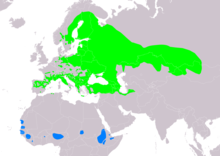| Ortolan bunting | |
|---|---|

| |
| Scientific classification | |
| Domain: | Eukaryota |
| Kingdom: | Animalia |
| Phylum: | Chordata |
| Class: | Aves |
| Order: | Passeriformes |
| Family: | Emberizidae |
| Genus: | Emberiza |
| Species: | E. hortulana
|
| Binomial name | |
| Emberiza hortulana Linnaeus, 1758
| |

| |
| Range of E. hortulana Breeding Non-breeding
| |
The ortolan (Emberiza hortulana), also called ortolan bunting, is a Eurasian bird in the bunting family Emberizidae, a passerine family now separated by most modern scholars from the finches, Fringillidae. The genus name Emberiza is from Alemannic German Embritz, a bunting. The specific name hortulana is from the Italian name for this bird, ortolana.[2] The English ortolan is derived from Middle French hortolan, "gardener".[3]
The ortolan is served in French cuisine, typically cooked and eaten whole. Traditionally diners cover their heads with their napkin or a towel while eating the delicacy. The bird is so widely used that its French populations dropped dangerously low, leading to laws restricting its use in 1999. In September 2007, the French government announced its intent to enforce long-ignored laws protecting the bird.[4][5]
- ^ BirdLife International (2017). "Emberiza hortulana". IUCN Red List of Threatened Species. 2017: e.T22720916A111136121. doi:10.2305/IUCN.UK.2017-1.RLTS.T22720916A111136121.en. Retrieved 12 November 2021.
- ^ Jobling, James A. (2010). The Helm Dictionary of Scientific Bird Names. London: Christopher Helm. pp. 145, 195. ISBN 978-1-4081-2501-4.
- ^ "Ortolan". Oxford English Dictionary (Online ed.). Oxford University Press. (Subscription or participating institution membership required.)
- ^ "Roasted songbird? French dish now a no-no". NBC News. Associated Press. 19 September 2007. Retrieved 30 March 2018.
- ^ Bell, Susan (9 September 2007). "France's songbird delicacy is outlawed". The Sunday Telegraph. Archived from the original on 30 June 2008. Retrieved 21 February 2008.
